ISSN ONLINE(2278-8875) PRINT (2320-3765)
ISSN ONLINE(2278-8875) PRINT (2320-3765)
| Alade Olusope Michael Department of Pure and Applied Physics, Ladoke Akintola University of Technology, P.M.B.4000, Ogbomoso, Oyo State, Nigeria. |
| Related article at Pubmed, Scholar Google |
Visit for more related articles at International Journal of Advanced Research in Electrical, Electronics and Instrumentation Engineering
This paper presents the experimental study on the radio wave propagation loss through long tropical forest environments at Very High Frequency, VHF (92.1MHz as a case study). The method of least square was employed to fit the experimental measured data. The measured data were then compared with some existing analytical and empirical radio propagation loss models, namely: Free Space Attenuation (FSA), Ground Reflection (GR) and Canopy-Ground Reflection (CGR), CGR plus foliage (ITU-R model) and CGR plus foliage (Weissberger model). CGR model provides the best fit for the propagation loss at VHF (92.1MHz) over long tropical forest. CGR model has minimum Normalized root-mean-square deviation, NRMSD = 0.106%. NRMSD between the measured data are the other existing models are: FSA~0.828%, GR~0.122%, CGR plus foliage (ITU-R)~0.410% and CGR plus foliage (Weissberger)~0.668%. The results obtained therefore shown that the radio wave propagation loss in the channel of consideration is due to tree-Canopy and Ground Reflections (CGR) rather than the foliage induced effect.
Keywords |
| Experimental measurement, Propagation loss, Very High Frequency, Long tropical forest |
INTRODUCTION |
| There are reports that the appearance of the forest (foliage and vegetation) medium in the part of the communication links can significantly affect the quality of the signal received because the forest components such as the randomly distributed leaves, Twigs, branches, tree’s groove, tree- canopy and tree’s trunk, air and ground layers cause reflection, refraction, diffraction, absorption and hence scatter the propagating radio waves which lead to path loss, and attenuation of the waves [1] – [13]. This will severely constrain the performance of the communication system and therefore has been of interest to researchers for many years. Several researches, theoretical and experimental works have been carried out and reported on the modeling of radio propagation loss through the forested channels at HF, VHF, UHF and microwaves bands [1] – [11]. The significance of radio wave propagation loss prediction in the communication channels can not be over-emphasizing in planning, budgeting and design of communication systems. It has been identified that the major adverse effect of radio wave propagation loss when not checked is the complete breakdown of communication systems [1], [9], [10], [13], [14]. |
| Despite numerous researches on the propagation loss modeling at HF, VHF and UHF, most of the existing models in the forested channels are theoretically and empirically based; they are based on the experiment carried out in the laboratories using dissipative slab materials and water in bottles as representations of ground and trees in the forest environments or a periodic dielectric rod array and an array of water-filled straws in the Laboratory as a simplified, scaled model of a typical forest [2] – [8]. They are not based on physical measurements in the real physical forest environments. Consequently, the models may not have high prediction accuracy, and need to be re-investigated. Also, to the best of our knowledge based on available information in the open literatures, there are no reported VHF radio wave propagation loss models available for very long depth forested channels [2] – [8]. |
| In this paper, some existing radio wave propagation loss models for the forested environments are briefly reviewed. As a continuation of the research progress on radio propagation characteristics through forested channels, the experimental measurements carried out on the radio wave propagation loss at VHF (92.1MHz as a case study) through long (~64km) forested communication channels are reported. The experimental measurement results obtained are compared with some existing propagation loss models: Free Space Attenuation (FSA), Ground Reflection (GR) and Canopy Ground Reflection (CGR) models, and integration of foliage-induced effect and reflection effect models: CGR plus ITU-R or SUM(CGR, ITU-R) and CGR plus Weissberger or SUM(CGR, Weissberger). Using the method of least square fit to the experimental measured data, CGR model gives the best fit for the radio wave propagation loss at VHF (92.1MHz) through long tropical forested channel. This paper is organized as follows: Section I gives the introduction of the behaviour of the propagation of radio wave through forest channels. Section II briefly review some related work on the radio wave propagation in the forest. Section III explains the experimental method used to carry out the study. Section IV explains the results obtained and gives the implications. The last section V concludes the paper and followed by references and author biography. |
REVIEW OF SOME PREVIOUS WORKS ON RADIO PROPAGATION LOSS IN THE FOREST ENVIRONMENTS |
| Gurung and Zhao, 2011 and McLarnon, 1997 as in [1], [12], gave some theoretical insight into the nature of radio wave propagation in VHF and Micro wave bands. The free space (Line of Sight, LOS) radio wave propagation loss can be calculated using Friis transmission formula given by [1], [12]: |
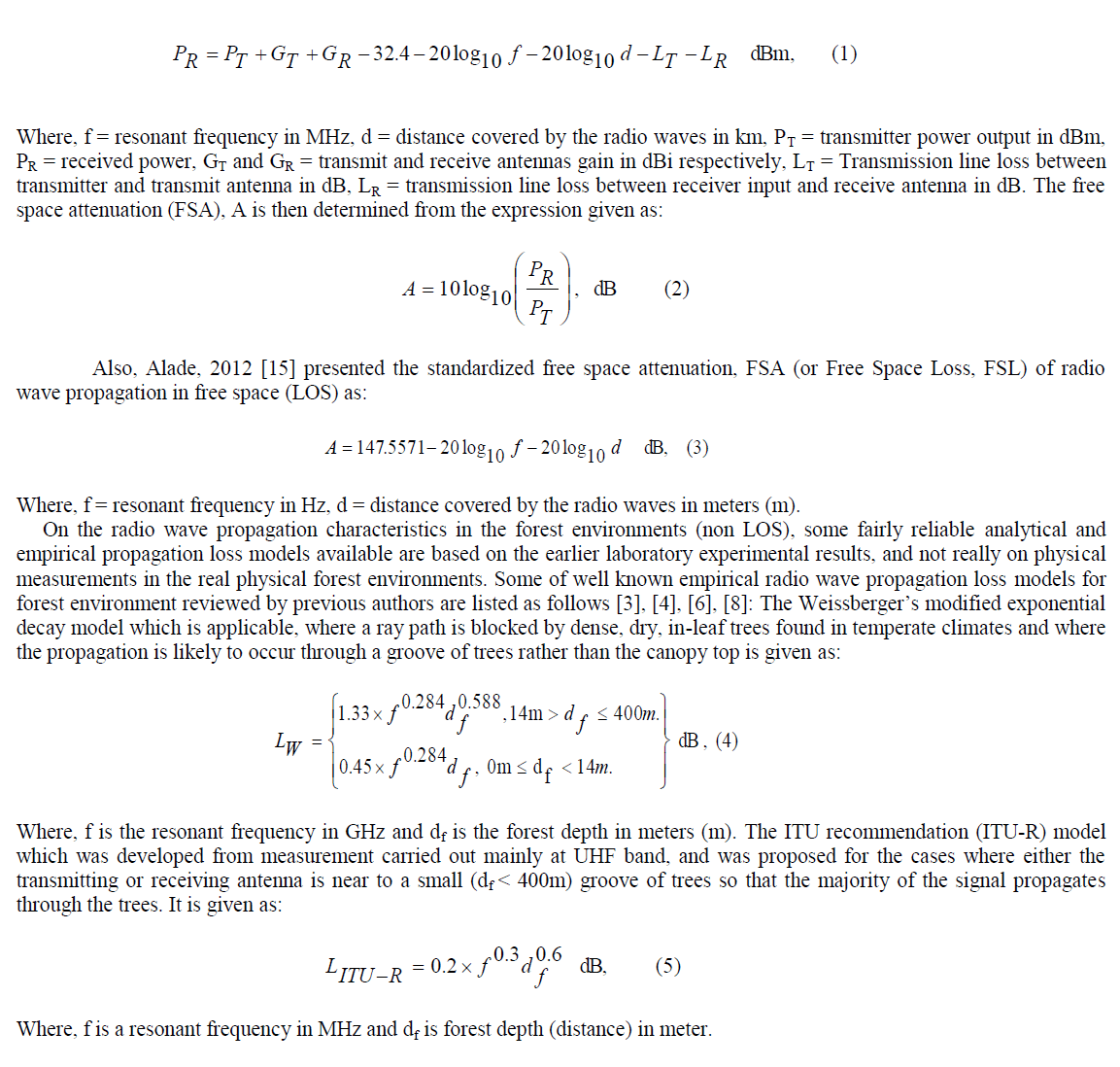 |
| As extension of research on modeling of radio wave propagation in the forest environments, a new method to model ground short-range propagation loss in forested areas with tree-canopy effect at the VHF and UHF bands using integration of the existing empirical foliage loss model (Weissberger and ITU-R or COST 235) and ray tracing model (as shown in the figure 1) to include the loss effect from ground and tree canopy reflections was developed by [6]. |
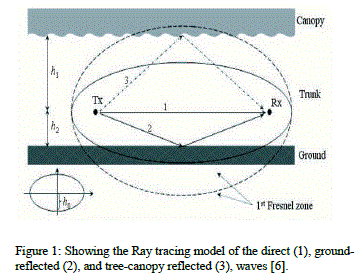 |
| The ray tracing model of the path loss L1-reflected due to the ground – reflection only is given by: |
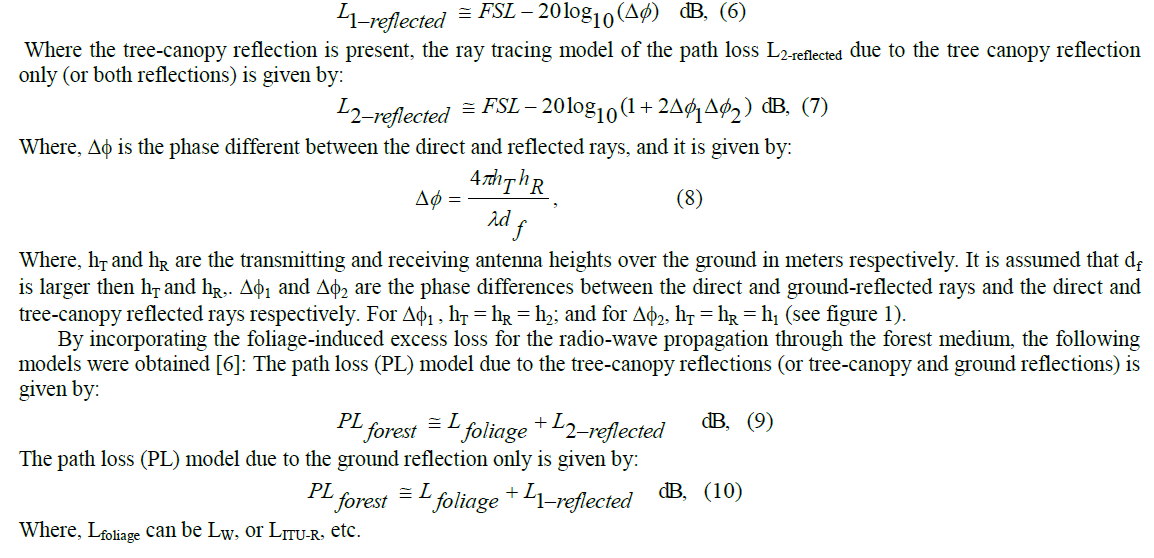 |
MEASUREMENTS CAMPAING AND COMPUTATIONS |
| The tropical forest where the experiment took place is located between Ogbomoso (LAT 8o 29’N, LONG 4o 29’E) and Oyo (LAT 7o 50’N, LONG 3o 56’E), Nigeria. The forest can be classified as medium dense to dense vegetations with mixed different types of plants. Figure 2a, b shows some parts of the forest. The forest consists of types of plants like Thick, Mahogany, Iroko, Mango and palm trees etc. Dense canopies are formed by the leaves of the trees. The average thickness (trunk diameter) and height of the trees range between 0.76m to 2.56m and 5.07m to 15.3m respectively. The spacing between the trees is irregular and ranges between 3m to 7m. The forest ground is covered with scrubs. The 92.1MHz, 3.5kW transmitter is employed in the experiment and located within the forest environment of interest. It consists of the transmitting antenna of 130m high, and the actual power radiated from the antenna after transmitter and cable losses are deducted is 2.5kW. The experimental measurement set up is as shown in the figure 2c. The experimental measurements were carried out by moving a low gain standard receiving dipole antenna (~0.5m from the ground surface) well matched to the receiver system (GSP810- Spectrum Analyser) set up inside a vehicle to measure the received signal power in dBm at 1km interval from the transmitting antenna up to 64km along the forest channel. The computations and statistical analyses were achieved with aid of Microsoftexcel2007. The graphical analyses were done with the aid of Matlab2007R. |
RESULTS AND DISCUSSION |
| In this paper, the radio wave propagation characteristics through long forested channel at VHF (92.1MHz as a case study) were investigated experimentally. The measurements were carried out in the months of October, November and December, 2011, under no wind, and no rain weather conditions with daily average ambient temperature ranges between 29oC and 34oC. Having measured the signal power received at every 1km interval to cover 64km through the desired forested channel, the measured attenuation in dB was deduced using Equation 2. Figure 3 is the plot of attenuation versus forest distance for the measurements, FSA, GR, and CGR models. Figure 4 is the plot of attenuation versus forest distance for the measurements, SUM(CGR, ITU-R) and SUM(CGR, Weissberger) models. All the existing analytical and empirical models were compared with the measurements. For all the cases, the attenuation decreases with distances, df along the forest channel. |
| The table 1 shows the statistical data for all the data plotted in Figures 3 and 4. The CGR model provides the best fit to the experimental measurements data, and closely followed by GR model. The FSA model of radio wave propagation loss, since it is based on free space communication links (LOS), does not include the additional loss on the propagation components such as direct wave and reflected, refracted, diffracted waves etc through the complex communication channels like forest, and therefore, it does not have ability to model forest links accurately. Also, based on the results obtained, SUM(CGR, ITU-R) and SUM(CGR, Weissberger) models which incorporated the foliage-induced excess loss for the radio-wave propagation through the forest medium have failed to adequately handle the radio waves propagation loss at VHF band through long forest depth. |
CONCLUSION |
| This paper presents the experimental modeling of VHF (92.1MHz) radio wave propagation loss through the long tropical forest depth channel. The results obtained shown that the radio wave propagation loss in the channel of consideration is due to the tree-canopy and ground reflections rather than the reflections from the groove and trunk of trees. If there is any additional propagation loss, it is not due to foliage induced effect. Therefore, the appropriate propagation loss model is tree-canopy and Ground Reflections (CGR) model. |
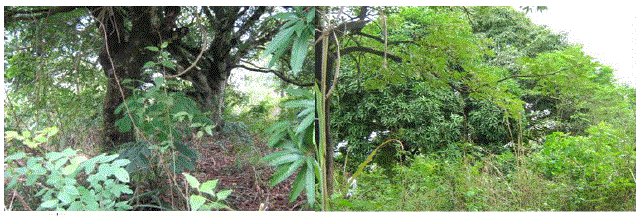 |
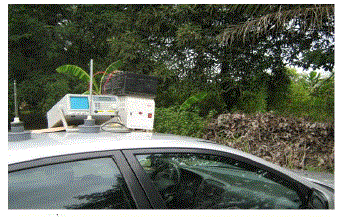 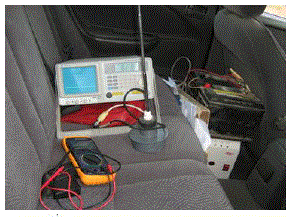 |
| Figure 2: Showing photographs of (a) part of the forest, (b) equipments for the measurements displayed and (c) the measurement set-up. |
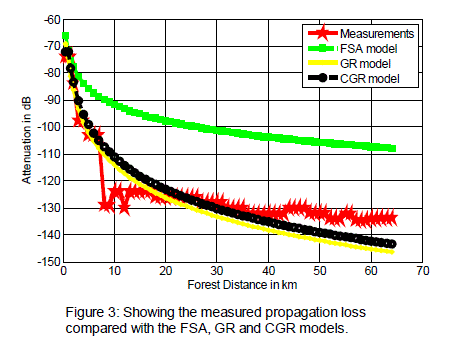 |
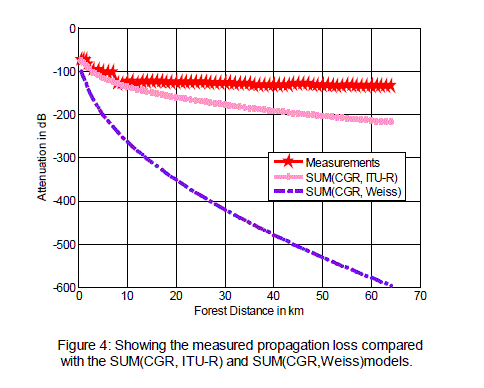 |
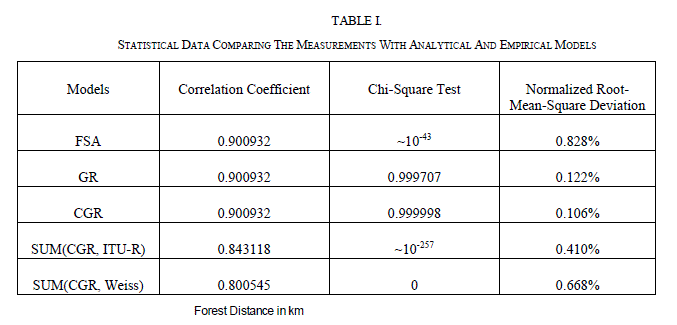 |
References |
|